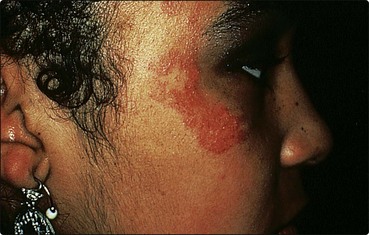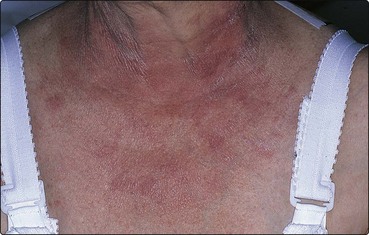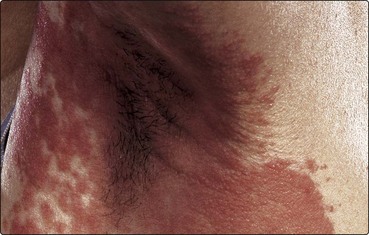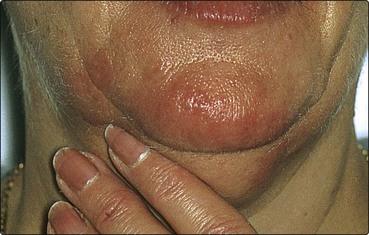Cosmetics
A cosmetic may be defined as any substance that is applied to the body for cleansing, beautifying, promoting attractiveness or altering the appearance. Cosmetics in some form are used by almost everyone. The market for cosmetic sales is vast and far exceeds that of dermatological products. Over recent years, the fields of cosmetology and dermatology have converged so that patients often present having had a reaction to a cosmetic or asking for advice about cosmetic usage. Some cosmetics are now being marketed as ‘cosmeceuticals’ with the claim that they have an ‘active’ ingredient, for example one that can ‘reverse ageing’.
The range of cosmetics and their usage
Cosmetics are normally used to enhance the appearance of the body, to clean it, to impart a pleasing smell or to mask an unpleasant one, or as a fashion accessory. Table 1 shows the range of common types of cosmetics.
Table 1 The range of cosmetics
| Site | Product |
|---|---|
| Skin | Moisturizer, cleanser, soap, make-up remover, powder, rouge, foundation, toner, perfume, aftershave, bath additive, sunscreen |
| Hair | Shampoo, conditioner, bleach, colourant, permanent waving, straightening, lacquer, gel, hair-removing agents |
| Eyelids | Mascara, eyeshadow, eyeliner, pencil |
| Nails | Nail varnish, false nails |
| Lips | Lipstick, lipgloss, sunscreen |
Constituents of cosmetics
The exact contents of a cosmetic depend on its proposed function. However, commonly used ingredients, some of which will be found in most cosmetics, are detailed in Table 2. Many cosmetics contain perfumes, preservatives and, quite often, a sunblock agent. Cosmetics are often emulsions (e.g. oil-in-water or water-in-oil). Full labelling of contents is required in the European Union, a measure strongly supported by dermatologists. This is a useful development for patients allergic to cosmetic ingredients because they are now able to avoid products that would be problematic. Certain preparations deserve special mention. They are discussed below.
Table 2 Some ingredients of cosmetics
| Ingredient | Action | Examples |
|---|---|---|
| Antioxidant | Prevent degradation | Butylhydroxyanisole, gallates, tocopherol |
| Colorant, dye | Colour | Cochineal, azo compounds, iron dioxides, para-phenylenediamine, titanium dioxide, metal salts, dihydroxyacetone in fake tan |
| Perfume | Smell or for masking smell | Myroxylon pereirae, limonene, geraniol, linalool |
| Preservative | Antimicrobial | Parabens, formaldehyde, iodo-propynyl butyl carbamate, methyl isothiazolin-one/chloro methyl isothiazolin-one, quaternium 15, bromo-nitropropane-diol, imidazolidinyl urea |
| Polyol | Humectant (retains water), emollient | Glycerol, propylene glycol, sorbitol |
| Oil, fat, wax | Emollient, lustre | Vaseline, almond oil, lanolin |
| Sun filter | Absorb or reflect UV | Titanium dioxide, oxybenzone, avobenzone |
| Tensioactive agent | Emulsifier, surfactant, detergent | Soaps, stearic and oleic acids |
| Water | Hydration | Purified water |
Para-phenylenediamine (PPD) hair dye
Hair dyes, principally PPD, are widely used. Adverse reactions occur in 5%, usually as a scalp or facial eczema. ‘Henna’ tattoos often contain 15–30% PPD and can induce allergy to PPD.
Nail preparations
Nail varnish is composed of a tosylamide–formaldehyde resin and colourants. Artificial nails are made of methacrylate acid esters and stuck on with acrylic glues.
Sunscreens
A sunscreen absorbs or reflects ultraviolet (UV) radiation. Absorbent agents are shown in Table 2. Titanium dioxide and zinc oxide are reflectant pigments. The sun protection factor (SPF) indicates the ratio of the reaction time to erythema when exposed to UV radiation for treated compared with untreated skin. Thus, using a factor 10 cream means that it should take 10 times longer for erythema to develop when in the sun. Some sunscreen creams are waterproof. Most need to be applied several times a day. Preparations available on prescription in the UK for patients with photodermatoses include Delph, Sunsense Ultra and Uvistat.
Camouflage cosmetics
These pigmented camouflage creams can be mixed to match the colour of the patient’s skin and are useful for individuals who have vitiligo, disfiguring birthmarks or scars. Prescribable examples include Covermark, Dermacolor, Keromask and Veil.
Reactions to cosmetics
Side-effects are comparatively rare when the vast usage of cosmetics is considered but, nonetheless, 12% or more of adults have had a reaction to a cosmetic. Some responses, e.g. stinging with aftershave due to the alcohol base, are expected and do not constitute a reaction. Some patients undoubtedly have a ‘sensitive’ skin and experience abreactions to a number of products. The preparations most likely to cause a problem are eye and facial cosmetics, antiperspirants and deodorants, hair colourants and soaps (Table 3). Reactions can be categorized as follows.
Table 3 Frequent adverse reactions to cosmetics
| Cosmetic | Reaction |
|---|---|
| Soap, detergent | Mostly irritant |
| Deodorant, antiperspirant | Irritant, sometimes allergic |
| Moisturizer | Irritant and allergic |
| Eye shadow | Mostly irritant |
| Mascara | Mostly irritant |
| Permanent wave agent | Irritant and allergic |
| Hair dye (mostly para-phenylenediamine) | Allergic |
| Shampoo | Mostly irritant |
Irritant contact dermatitis
This is particularly seen in atopics and those with a ‘sensitive’ skin. Soaps, which are drying and alkaline (the normal pH of facial skin is about 5.5), and deodorants cause mostly irritant dermatitis (Fig. 1). Lanolins, detergents and preservatives may also be irritant.
Allergic contact dermatitis
Allergic contact dermatitis most commonly develops to fragrances, preservatives, dyes (e.g. PPD), lanolins, metallic salts (in some eye cosmetics) and the permanent wave agent glyceryl mono-thioglycolate (Figs 2 and 3). The eruption usually develops at the place of application of the product (usually the face), but this is not always so, as substances can be transferred to another site where they cause symptoms. For example, contact allergy to tosylamide–formaldehyde resin (Fig. 4) in nail varnish most often manifests as an eruption around the eyelids or on the neck.
Contact urticaria and other adverse reactions
Contact urticaria presents as a wheal and flare response within a few minutes of the application of a substance. It may occur with compounds in perfumes, shampoos and hair dyes. Other adverse reactions include nail dystrophies caused by nail cosmetic or artificial nail use, hair breakage and weathering due to improper use of permanent waving, hair straighteners or dyes, pigmentation and acne.
Management of cosmetic reactions
A patient intolerant of a cosmetic should stop the use of all cosmetics. If necessary, a topical steroid is prescribed until the reaction subsides. All the cosmetics and preparations that have been used must be examined for ingredients, and patch testing (p. 126) performed if appropriate. Alternative cosmetics can then be introduced, but kept to a minimum.
Cosmetics
 A cosmetic is a substance applied to the body for cleansing, to promote attractiveness or to alter the appearance. Now used by both sexes.
A cosmetic is a substance applied to the body for cleansing, to promote attractiveness or to alter the appearance. Now used by both sexes.
 A cosmetic cream typically contains emollients, emulsifiers, colourants, perfumes and preservatives to prevent oxidation and the growth of micro-organisms. Sun filters may also be included to prolong shelf-life and for their ‘anti-photoageing’ effect.
A cosmetic cream typically contains emollients, emulsifiers, colourants, perfumes and preservatives to prevent oxidation and the growth of micro-organisms. Sun filters may also be included to prolong shelf-life and for their ‘anti-photoageing’ effect.
 Reactions to cosmetics may take the form of irritant or allergic contact dermatitis, contact urticaria or pigmentary change.
Reactions to cosmetics may take the form of irritant or allergic contact dermatitis, contact urticaria or pigmentary change.
 The commonest causes of irritant reactions are soaps, shampoos and deodorants, often because of detergents or preservatives.
The commonest causes of irritant reactions are soaps, shampoos and deodorants, often because of detergents or preservatives.
 The substances that most frequently cause allergic contact dermatitis are fragrances or preservatives (found in most cosmetics, e.g. moisturizers) and dyes (e.g. PPD found in hair colourants).
The substances that most frequently cause allergic contact dermatitis are fragrances or preservatives (found in most cosmetics, e.g. moisturizers) and dyes (e.g. PPD found in hair colourants).



